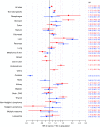Cancer incidence in persons with type 1 diabetes: a five-country study of 9,000 cancers in type 1 diabetic individuals
- PMID: 26924393
- PMCID: PMC4826427
- DOI: 10.1007/s00125-016-3884-9
Cancer incidence in persons with type 1 diabetes: a five-country study of 9,000 cancers in type 1 diabetic individuals
Abstract
Aims/hypothesis: An excess cancer incidence of 20-25% has been identified among persons with diabetes, most of whom have type 2 diabetes. We aimed to describe the association between type 1 diabetes and cancer incidence.
Methods: Persons with type 1 diabetes were identified from five nationwide diabetes registers: Australia (2000-2008), Denmark (1995-2014), Finland (1972-2012), Scotland (1995-2012) and Sweden (1987-2012). Linkage to national cancer registries provided the numbers of incident cancers in people with type 1 diabetes and in the general population. We used Poisson models with adjustment for age and date of follow up to estimate hazard ratios for total and site-specific cancers.
Results: A total of 9,149 cancers occurred among persons with type 1 diabetes in 3.9 million person-years. The median age at cancer diagnosis was 51.1 years (interquartile range 43.5-59.5). The hazard ratios (HRs) (95% CIs) associated with type 1 diabetes for all cancers combined were 1.01 (0.98, 1.04) among men and 1.07 (1.04, 1.10) among women. HRs were increased for cancer of the stomach (men, HR 1.23 [1.04, 1.46]; women, HR 1.78 [1.49, 2.13]), liver (men, HR 2.00 [1.67, 2.40]; women, HR 1.55 [1.14, 2.10]), pancreas (men, HR 1.53 [1.30, 1.79]; women, HR 1.25 [1.02,1.53]), endometrium (HR 1.42 [1.27, 1.58]) and kidney (men, HR 1.30 [1.12, 1.49]; women, HR 1.47 [1.23, 1.77]). Reduced HRs were found for cancer of the prostate (HR 0.56 [0.51, 0.61]) and breast (HR 0.90 [0.85, 0.94]). HRs declined with increasing diabetes duration.
Conclusion: Type 1 diabetes was associated with differences in the risk of several common cancers; the strength of these associations varied with the duration of diabetes.
Keywords: Cancer incidence; Cancer rate ratio; Cancer subtypes; Diabetes duration.
Figures



References
-
- Fall K, Garmo H, Gudbjornsdottir S, Stattin P, Zethelius B. Diabetes mellitus and prostate cancer risk; a nationwide case-control study within PCBaSe Sweden. Cancer Epidemiol Biomark Prev: Publ Am Assoc Cancer Res, cosponsored by the Am Soc Prev Oncol. 2013;22:1102–1109. doi: 10.1158/1055-9965.EPI-12-1046. - DOI - PubMed
Publication types
MeSH terms
LinkOut - more resources
Full Text Sources
Other Literature Sources
Medical

